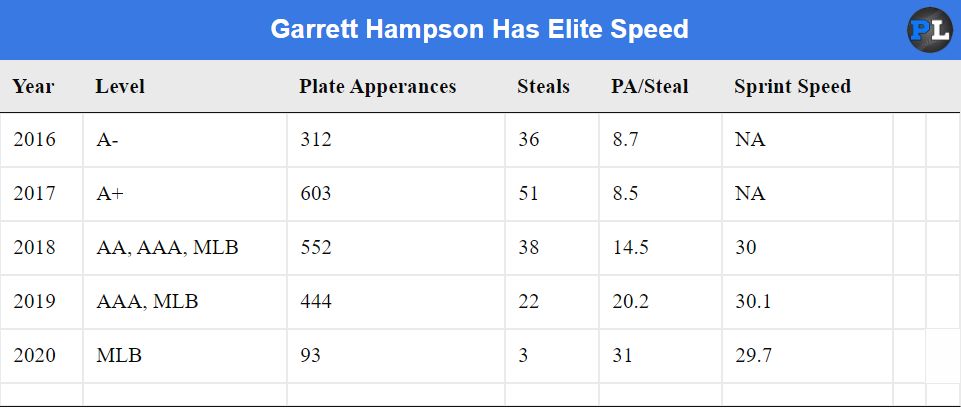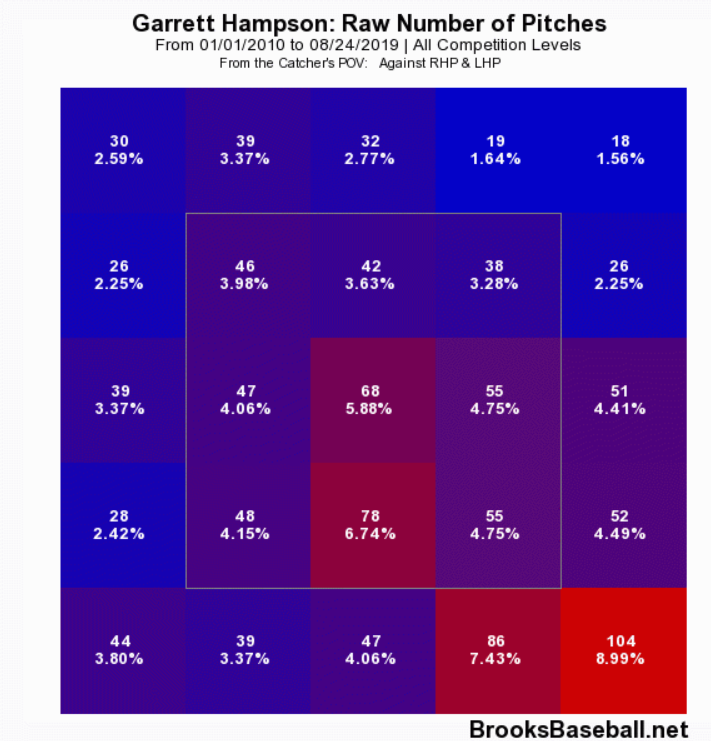Garrett Hampson belongs to a special breed of players: former top prospects who’ve struggled to pick up consistent playing time, despite all appearances pointing to them being the best option for their team. Kyle Tucker repeatedly sitting behind Aledmys Díaz this summer was one example of that. Carter Kieboom struggling to pick up regular ABs for a Nationals team without a clear 3B option is another.
In a shocking turn of events, Daniel Bard has been named the starting 2nd baseman, pushing Garrett Hampson back to the bench. https://t.co/kxg1iE90BH
— Eric Cross (@EricCross04) July 17, 2020
Garrett Hampson last 4 starts: 4/13, 4 R, HR, 3 RBI, 2 BB
Dates of last 4 starts: 8/7, 8/6, 8/1, 7/29Producing when starting, but PT is still idiotically sporadic. Has started two games in a row though! Keep an eye on this. #Rockies #FantasyBaseball
— Eric Cross (@EricCross04) August 8, 2020
Garrett Hampson…
– Has led off in six straight games
– Has a 4-game hitting streak
– Has six hits in his last two games
– Is slashing .325/.391/.575 this season
– Is welcoming all that doubted him back into his life#FantasyBaseball #Rockies— Eric Cross (@EricCross04) August 13, 2020
Garrett Hampson is out of the lineup for the 2nd game in a row after performing well in his stint as the leadoff hitter.
The ineptitude and idiotic decisions by the Rockies is astounding.
— Eric Cross (@EricCross04) August 21, 2020
And yet, Garrett Hampson might be the most frustrating of them all. This series of tweets by Eric Cross, who was paired with me in the absolutely essential mentorship program used to help make fantasy baseball more inclusive and accessible, does an excellent job of illustrating just how frustrating having a team with Hampson on it can be. One week, Hampson will play every game and look like a future star, and then next the Rockies will tire of having exciting young talent and look longingly towards Matt Kemp. Ultimately, however, there’s nothing we can do about Hampson’s playing time. That’s decided by the whims of the Rockies managerial staff and front office. What we can do, is figure out whether a full-time Hampson would be much good.
To understand why so many people are tantalized by Hampson is to first look at his stolen base potential. Stolen bases on their own are more valuable than any other offensive category, just because they’re so comparatively rare. Home runs go hand in hand with runs, RBIs, and batting average – they have a strong positive correlation. Stolen bases do not have nearly as strong a correlation with other categories. Take Juan Soto as an example. He is elite offensively but only contributes about 10 steals in a full season. And he’s considered a well-rounded player. Others, like Nolan Arenado, contribute in four categories but are lucky to reach three steals in a season. This scarcity is why players like Adalberto Mondesi who are mediocre offensively, even at their best, get drafted so high.
Garrett Hampson could very well reach the pinnacle of the stolen base world.
A lot of those numbers are off the charts. Hampson’s max career sprint speed of 30.1 feet per second is within the top ten in all of baseball. And, while he may appear to have had a slight drop off this season, sprint speed numbers are down across the board. I’m not quite sure why that’s the case – it could be the new camera system that MLB is using, it could be players having less time to ramp up this season, it could be a completely different factor altogether. The important thing is that in 2020 alone, Hampson is 5th in sprint speed.
Raw speed does not a base stealer make, however. This year’s sprint speed leader is Roman Quinn, who’s never played well enough to garner enough plate appearances to make a stolen base leaderboard. Tied for 2nd are Harrison Bader, who has never stolen more than 15 bases even while appearing in over 130 games, Adam Engel, who’s bad enough at reading pitchers that he’s turned his 80-grade speed into only a 68% success rate on steals, and Trea Turner, one of the best base stealers alive.
Fortunately, Garrett Hampson knows how to steal and frequently has the green light. Without reading too much into his low steal numbers in the tiny sample size that is 2020, Hampson has always stolen bases at an elite rate. Players who can steal 20 bags in a year are immensely valuable, let alone Hampson’s potential to steal 30, 40, or even 50 if everything breaks right for him. Those are the kind of numbers that Adalberto Mondesi attempts to reach each year, and if Hampson can reach them consistently, then his ADP will creep higher and higher.
Some of you may be seeing Hampson’s comparison to Mondesi and be slightly concerned. After all, if I’m going to use the example of a player who steals a ton of bases, why use one of the biggest busts of the season thus far, a player who leads the league in failed stolen base attempts and has been worth negative WAR? The answer is that as good a baserunner as a player could be, if he can’t hit, he won’t return value.
So – can Hampson hit? When we look at Hampson’s hitting ability its probably best to split his career into two parts. Up until August 24th of last year, Hampson struggled immensely to hit the ball. His OPS up to that point in his career was .573, a number that no amount of baserunning would have been able to make look good. Fortunately, at that point, Hampson changed his swing. Thomas Harding at MLB.com reported that the Rockies hitting coach suggested a few changes to Hampson. Hampson took heed and for the rest of the season had an OPS near .900.
See if you can find the differences in Hampson’s swing before and after the change.
Here’s his swing before the change:
https://gfycat.com/miniaturegleefulgrassspider
And here’s after:
https://gfycat.com/samegiddycrane
Hampson starts farther away from the plate now and does a much better job of including his leg kick as part of his swing, instead of something he did before it. The changes have worked! Hampson is much better at making contact now, and his numbers have improved from one of the worst regulars in baseball to solidly above average.
There are, however, still two significant worries about Hampson’s batting ability if he wants to avoid falling into the problematic player group of Adalberto Mondesis, Jarrod Dysons, and Mallex Smiths.
The first concern is Hampson’s lack of power. Hampson has hit 10 home runs in 424 ABs up to this point in his career, a number solidly below average but not necessarily concerning. Looking closer at Hampson’s power numbers reveals numbers much more concerning, however. Hampson is one of the worst players in all of baseball in Hard-Hit %, (which tracks the percentage of batted ball events a player hits at over 95 MPH), meaning that Hampson rarely hits balls hard enough to give himself the potential for home runs. Launch angle is important, but if a player makes poor contact at a good angle, the ball is going to die in the outfield.
Okay, so Hampson isn’t really hitting for power right now. Maybe he has the potential to do so eventually – he’s played less than a full season, after all, and a lot of players don’t unlock every part of their game right away. Unfortunately, Hampson doesn’t seem to have much raw power either. Hampson’s max exit velocity this year is 107.2 MPH, good for 238th in baseball. 
This exit velocity histogram doesn’t leave space for optimism either. If Hampson did have raw power that he was having trouble harnessing, we would be more likely to see a lot of inconsistency within this chart, with spikes at the top (when he gets all of the ball) and at the bottom (if his overall average is as low as 84.5 MPH, and he did have a lot of batted ball events at high speeds, he’d need something too offset those numbers). Instead, we see a fairly consistent, gentle chart. That’s problematic and shows that Hampson probably doesn’t have a lot of power.
Is that necessarily a problem, however? Hampson does play half his games in Coors, after all, where even average balls leave for home runs and singles easily become doubles. Hampson’s power-hitting teammates back up that postulate. Trevor Story is an elite power hitter but has only slightly above average power-hitting metrics. Nolan Arenado and Charlie Blackmon’s metrics are downright below average. That’s insane! Arenado has been one of the most consistent home run hitters in recent memory, and Blackmon has hit .390 so far this year. Still, their numbers are below average, not downright bad, like Hampson’s have been.
What can we make of all this? Hampson will probably be gifted some home runs as long as he stays in Colorado. He’s hit 10 so far in his career, and Statcast’s No Doubter metric suggests that if anything, he’s been slightly unlucky. Expecting 15 home runs a season from Hampson is probably fair. At the same time, Hampson will probably never reach 25 or 30 bombs unless he makes some sort of significant change that I don’t see a path towards.
The second concern with Hampson is a significant hole in his swing.
Look at the astounding number of pitches that Hampson has seen down and in. Hampson has seen over twice as many pitches down and in as compared to the number he’s seen down and away, and over three times as many as he’s seen up and in or up and away. These numbers admittedly are not quite so extreme as they may first seem – a lot of players see more pitches down and in than in any other spot – but Hampson’s are uniquely high. That’s for good reason. Hampson, who whiffs at a fairly average rate, has a whiff rate of nearly 20% on these pitches. That’s driven by his struggles to identify low breaking balls. So far this season, Hampson has swung on nearly half of breaking balls below the zone, a problematic approach.
What does all of this mean? It means that as tantalizing as Hampson’s skill set is, there may be a very real reason why he’s not receiving consistent ABs. Until Hampson can consistently take low breaking balls, pitchers will exploit that tendency, and Hampson will struggle. If, however, Hampson ever does figure it out, he could easily be a high batting average, 15 homer, and 35 steal player.
For the rest of this season, Hampson probably isn’t worth valuing much. Even if he does improve his plate approach, those improvements will take time to notice. The Rockies, of all organizations, are probably not an organization prepared to notice those improvements quickly. For the future, however, Hampson has a very real chance to be an impact player on the basepaths. Throw in a solid bat and Hampson is a player to buy in dynasty leagues.
Let’s just hope he can continue to go ham on the basepaths.
Photo by Ric Tapia/Icon Sportswire | Adapted by Michael Packard (@designsbypack on Twitter & IG)




Great breakdown as always. This author has the ability to helpfully diagnosis significance based on careful observation. That is a gift.
Good read. Wonder if his exit velo is skewed by bunting; saw him bunt for a single in last night’s game.
That’s a totally valid response to his average exit velocity, which is why I focused more on the max exit velocity and the histogram. If it had been skewed much by bunting, we would probably be seeing a large bump near the bottom of the histogram, and we wouldn’t see any effect at all on the max exit velocity (because he’s not bunting in every plate appearance)